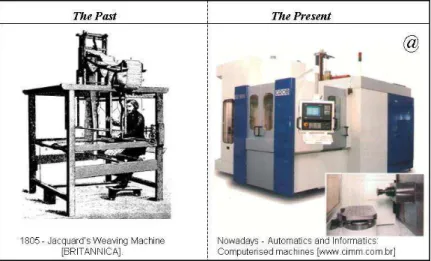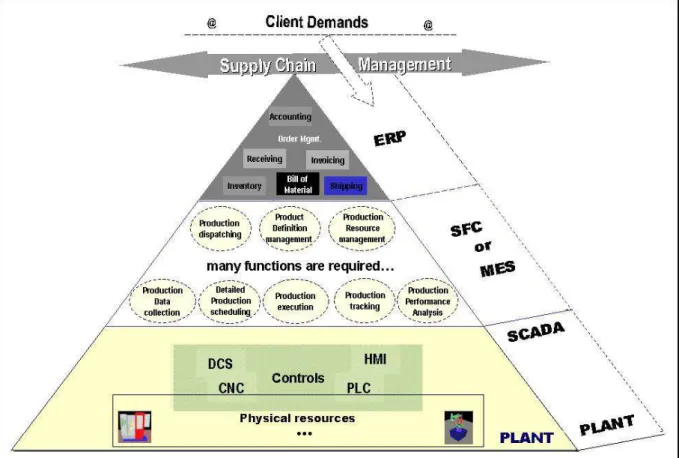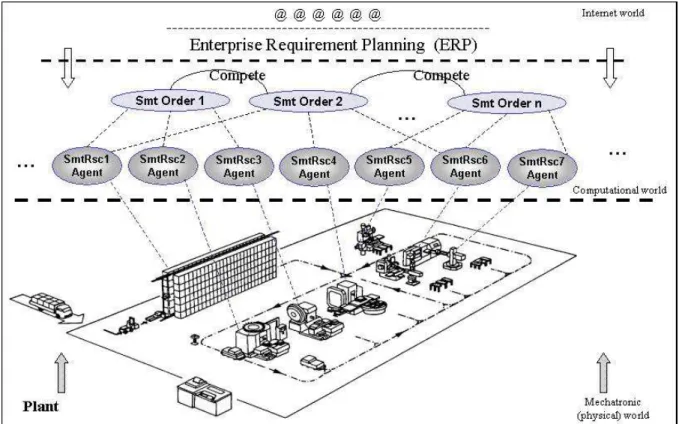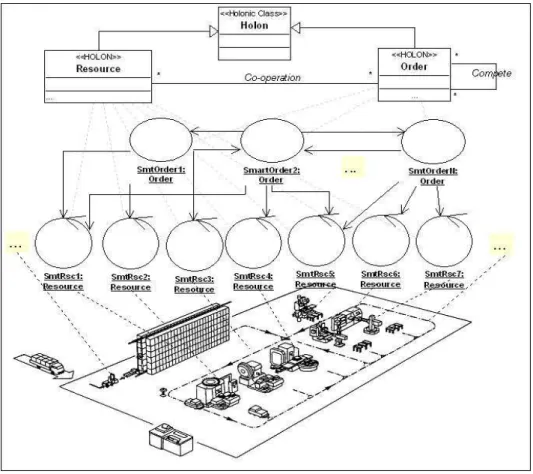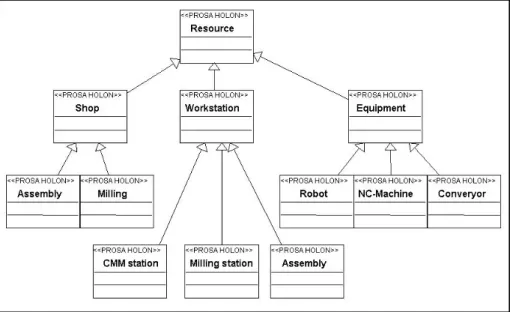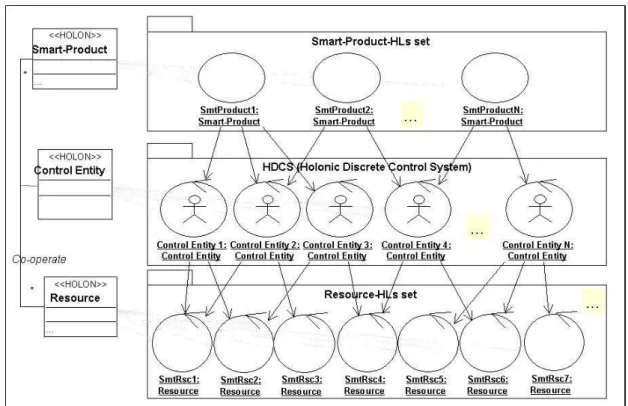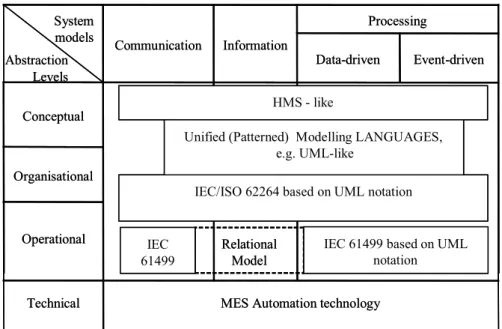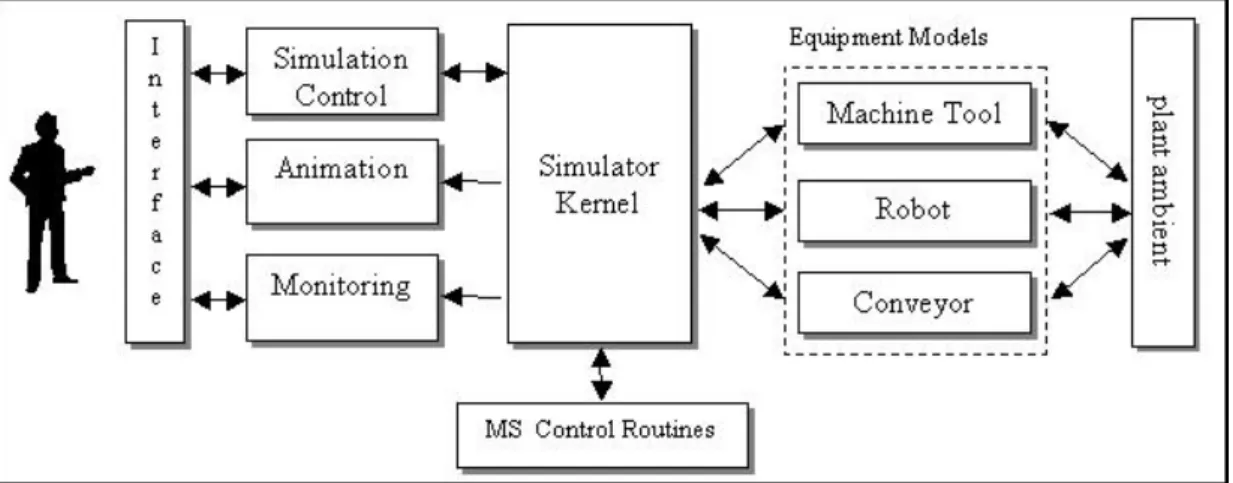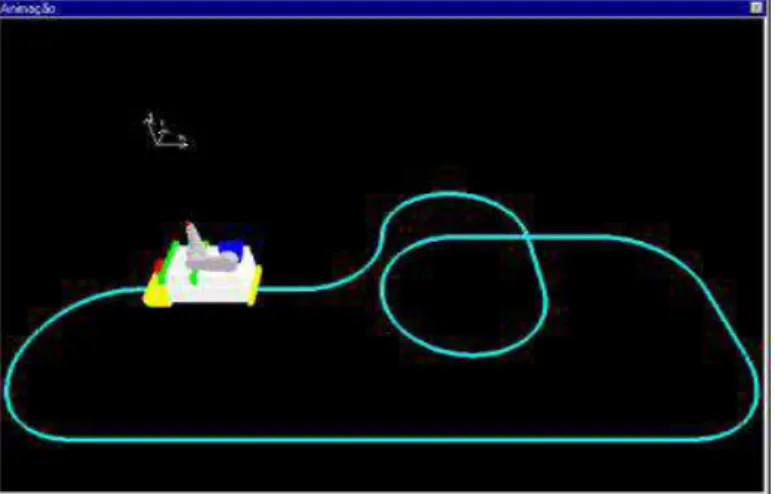HAL Id: tel-01748624
https://tel.archives-ouvertes.fr/tel-01748624v2
Submitted on 29 Jun 2006
HAL is a multi-disciplinary open access archive for the deposit and dissemination of sci- entific research documents, whether they are pub- lished or not. The documents may come from teaching and research institutions in France or abroad, or from public or private research centers.
L’archive ouverte pluridisciplinaire HAL, est destinée au dépôt et à la diffusion de documents scientifiques de niveau recherche, publiés ou non, émanant des établissements d’enseignement et de recherche français ou étrangers, des laboratoires publics ou privés.
Simulation Tool and Proposition of a Meta-Model for Holonic Control
Jean Marcelo Simão
To cite this version:
Jean Marcelo Simão. A Contribution to the Development of a HMS Simulation Tool and Proposition of a Meta-Model for Holonic Control. Software Engineering [cs.SE]. Université Henri Poincaré - Nancy 1; Universidade Tecnológica Federal do Paraná; Centro Federal de Educação Tecnológica do Paraná, 2005. Portuguese. �NNT : 2005NAN10022�. �tel-01748624v2�
CENTRO FEDERAL DE EDUCAÇÃO TECNOLÓGICA DO PARANÁ (CEFET-PR) Programa de Pós-graduação em Engenharia Elétrica e Informática Industrial (CPGEI)
UNIVERSITÉ HENRI POINCARÉ (UHP) Centre de Recherche en Automatique de Nancy (CRAN)
A CONTRIBUTION TO THE DEVELOPMENT OF A HMS SIMULATION TOOL AND PROPOSITION OF A
META-MODEL FOR HOLONIC CONTROL
Doctoral Thesis
by
Jean Marcelo SIMÃO
Examining Board:
Advisors:
Prof. Paulo Cézar STADZISZ Centro Federal de Educação Tecnológica do Paraná (CEFET-PR) Prof. Gérard MOREL Université Henri Poincaré (UHP)
President:
Prof. Luis Allan KÜNZLE Universidade Federal do Paraná (UFPR)
Reporters:
Prof. Bernard GRABOT École Nationale d’Ingénieurs de Tarbes (ENIT) Prof. José Eduardo Ribeiro CURY Universidade Federal de Santa Catarina (UFSC)
Examiners:
Prof. Carlos Eduardo Trabuco DÓREA Universidade Federal da Bahia (UFBA)
Prof. César Augusto TACLA Centro Federal de Educação Tecnológica do Paraná
Curitiba, Paraná, Brazil June 13, 2005
J E A N M A R C E L O S I M Ã O
A CONTRIBUTION TO THE DEVELOPMENT OF A HMS SIMULATION TOOL AND PROPOSITION OF A
META-MODEL FOR HOLONIC CONTROL
Doctoral Thesis submitted in partial fulfillment of the requirements for the degree of Doctor of Science (DSc) at the Graduate School in Electrical Engineering and Industrial Computer Science (CPGEI), The Federal Center of Education in Technology of Paraná (CEFET-PR), emphasis on Industrial Computer Science.
Advisor: Prof. Dr. Paulo Cézar Stadzisz.
Doctoral Thesis equally submitted in partial fulfillment of the requirements for the degree of Doctor (Dr.) of Henri Poincaré University (UHP) at UHP, Research Center for Automatic Control of Nancy (CRAN), emphasis on Automatics, Signal Treatment, and Computer Engineering.
Advisor: Prof. Dr. Gérard Morel
Curitiba, Paraná, Brazil.
June 13, 2005
CNRS UMR 7039 Faculté des Sciences
UFR Sciences Techniques Mathématiques Informatique Automatique
Ecole Doctorale IAEM Lorraine DFD Automatique
Université Henri Poincaré (UHP) – Nancy I France
Programa de Pós-graduação em Engenharia Elétrica e Informática Industrial (CPGEI)
Centro Federal de Educação Tecnológica do Paraná (CEFET-PR) – Brasil
THÈSE en co-tutelle entre l’UHP et le CEFET-PR
présentée en vue de l’obtention des titres de Docteur de l'Université Henri Poincaré, Nancy I en Automatique, Traitement du Signal, Génie Informatique
et
Doutor em Ciências pelo Centro Federal de Educação Tecnológica do Paraná na área de Engenharia Elétrica e Informática Industrial
par
Jean Marcelo SIMÃO
A Contribution to the Development of a HMS Simulation Tool and Proposition of a Meta-Model for Holonic Control
Contribution au Développement d’un Outil de Simulation de Systèmes Holoniques de Production et Proposition d’un Meta-Modèle de Contrôle Holonique
Uma Contribuição ao Desenvolvimento de uma Ferramenta de Simulação de Sistemas de Manufatura Holônicos e Proposição de um Meta-Modelo para o Controle Holônico.
Thèse soutenue le 13 juin 2005 à Curitiba (Paraná) Brésil – CEFET-PR Membres du Jury:
Président et Rapporteur : Prof. Bernard GRABOT École Nationale d’Ingénieurs de Tarbes Rapporteur : Prof. José Eduardo Ribeiro CURY Universidade Federal de Santa Catarina Directeur de Thèse : Prof. Gérard MOREL Université Henri Poincaré – Nancy I Directeur de Thèse : Prof. Paulo Cézar STADZISZ Centro Fed. de Educ. Tecnol. do Paraná Examinateur Invité : Prof. Carlos Eduardo Trabuco DÓREA Universidade Federal da Bahia
Examinateur Invité : Prof. Luis Allan KÜNZLE Universidade Federal do Paraná Examinateur Invité : Prof. César Augusto TACLA Centro Fed. de Educ. Tecnol. do Paraná
Centre de Recherche en Automatique de Nancy (CRAN) – UHP
Programa de Pós-graduação em Engenharia Elétrica e Informática Industrial (CPGEI) – CEFET-PR
Acknowledgements
I would like to express my sincere and deep gratitude to Mr. Stadzisz for intensely guiding and advising me during the development of my research efforts from the master thesis to the current doctoral thesis. I would also like to thank Mr. Stadzisz for his more general advice, as well as for his sincere friendship.
In the same way, I would like to demonstrate my sincere and deep gratitude to Mr. Morel, for having invited me to do a part of my doctoral project in France, where he has given me a lot of advice, orientation, and support. My gratitude to Mr. Morel extends to his friendship and his teaching about the fascinating French culture.
Other acknowledgements go in particular to Mr. Grabot and to Mr. Cury. I am profoundly grateful for their acceptance and for the attention they have devoted to correcting this doctoral thesis. I am equally thankful to Mr. Dórea, Mr. Künzle, and Mr. Tacla for their acceptance and for their attention in correcting this doctoral thesis.
Finally, I would like give a special thanks to Mr. Künzle for his advice and friendship during these past six years and to Mr. Tacla for his advice and friendship this past year. Similarly, I would like to mention my laboratory friends, both in France and Brazil, for seemingly unlimited professional help and friendship. More specifically, I express my friendship to L.F.F. Rosinha (in memoriam) and A.
Koscianski, who have developed works on which the current project is based.
In general, I would like to express all my indebtedness to the people that have personally or professionally helped me along my way. It would be, perhaps, impractical to mention each one here;
however each one indubitably has been very present in my thoughts and prayers. Specifically, I would like to thank my family, my very close friends, and S. L. for all the sentimental and material help that they have provided me.
I would also like to express my appreciation to the Brazilian and French governments for the material and financial support they have provided me. In particular, I would like to thank CAPES (Coordenação de Aperfeiçoamento de Pessoal de Nível Superior) for the national and international scholarship covering the period between May of 2001 and April of 2005. In addition, I am very thankful to CPGEI/CEFET-PR, CRAN-UHP, and other concerned institutions, for all the support they have provided me.
Finally, I express my infinite thankfulness to the Supreme Being.
Sincerely,
Jean Marcelo Simão.
Remerciements
Je voudrais exprimer ma sincère et profonde gratitude à M. Stadzisz pour intensivement diriger et conseiller le développement de mes travaux de recherche depuis du master jusqu’au présent travail de doctorat. Je voudrais encore remercier M. Stadzisz pour les conseils dans un sens large et aussi pour l’amitié sincère.
Également, je tiens à démontrer mon sincère et profonde gratitude au M. Morel. M. Morel m’a invité à son laboratoire pour réaliser une partie du doctorat en France en m’apportant beaucoup de conseils, de support et de l´orientation. Ma gratitude à M. Morel concerne tout son amitié et ses enseignements sur la fascinante culture française.
Mes remerciements sont aussi particulièrement adressés à M. Grabot et à M. Cury à qui je remercie pour avoir accepté de reporter ce travail de thèse. Pareillement, mes remerciements sont présentés à M.
Dórea, M. Künzle et M. Tacla pour ses acceptations et pour ses attentions pour examiner ce travail de thèse.
En outre, je voudrais faire une mention spéciale à M. Künzle pour ses conseils et pour son amitié pendant les six dernières années et à M. Tacla pour ses conseils et pour son amitié dans la dernière année. Similairement, je voudrais mentionner les amis des laboratoires, en France et au Brésil, pour leurs innombrables aides professionnelles et leur amitié. Spécialement, j’exprime mon amitié à L. F. F.
Rosinha (in memoriam) et à A. Koscianski qui ont développé des travaux de base en permettant le présent travail de recherche.
En général, je voudrais exprimer toute ma reconnaissance aux personnes qui m’ont aidé, personnellement ou professionnellement, dans mon chemin. Il serait, peut-être, impraticable de les mentionner tous, cependant chacun a certainement beaucoup d’attention dans mes pensées et dans mes prières. Spécifiquement, je voudrais remercier ma famille, mes amis et S.L. de toute leur aide sentimentale et matérielle.
L’appréciation relative au support matériel et financier est aussi présentée aux gouvernements brésilien et français. Particulièrement, je voudrais remercier la CAPES (Coordenação de Aperfeiçoamento de Pessoal de Nível Superior) pour les bourses des études (national et international) entre mars 2001 et avril 2005. Je remercie encore et beaucoup, le CPGEI/CEFET-PR, le CRAN-UHP et les institutions concernés pour tout le support.
Finalement, j’exprime toute mon infinité gratitude à l’Être Suprême
Sincèrement.
Jean Marcelo Simão
Agradecimentos
Eu gostaria de expressar minha sincera e profunda gratidão ao Sr. Stadzisz por intensivamente orientar e aconselhar o desenvolvimento de meus trabalhos de pesquisa a partir do trabalho de mestrado até o presente trabalho de doutorado. Ainda, eu gostaria de agradecer o Sr. Stadzisz pelos conselhos num amplo sentido bem como pela amizade sincera.
Igualmente, eu gostaria de demonstrar minha também sincera e profunda gratidão ao Sr. Morel que me convidou para fazer parte do trabalho de doutorado na França, onde ele me concedeu vários conselhos, orientações e suporte. Minha gratidão ao Sr. Morel também inclui toda sua amizade e o seu ensinar sobre a fascinante cultura francesa.
Outros agradecimentos são particularmente feitos ao Sr. Grabot e ao Sr. Cury, eu estou profundamente agradecido pelas suas aceitações e atenções para relatar este trabalho de tese. De uma mesma maneira, meus agradecimentos são apresentados ao Sr. Dórea, ao Sr. Künzle e ao Sr. Tacla pelas suas aceitações e atenções para examinar este trabalho de tese.
Ainda, eu gostaria de fazer uma menção especial de agradecimento ao Sr. Künzle pelos seus conselhos e amizade durante estes últimos seis anos e ao Sr. tacla pelos seus conselhos e amizade neste último ano. Similarmente, eu gostaria de mencionar os amigos dos laboratórios, na França e no Brasil, pelas incontáveis ajudas profissionais e amizade. Especialmente, eu expresso minha amizade por L.F.F.
Rosinha (in memoriam) e por A. Koscianski que desenvolveram trabalhos de base, permitindo o presente trabalho de pesquisa.
Em geral, eu gostaria de expressar todo meu reconhecimento para com as pessoas que têm, de forma pessoal ou profissional, ajudado no meu caminho. Seria, talvez, impraticável mencionar cada um aqui, entretanto cada um tem indubitavelmente muita atenção nos meus pensamentos e nas minhas orações. Especificamente, eu gostaria de agradecer por toda a ajuda sentimental e material que minha família, meus amigos próximos e S.L. têm me proporcionado.
A apreciação relativa ao suporte material e financeiro é também apresentado aos governos brasileiro e francês. Particularmente, eu gostaria de agradecer à CAPES (Coordenação de Aperfeiçoamento de Pessoal de Nível Superior) pelas bolsas de estudo (nacional e internacional) entre março de 2001 e abril de 2005. Eu ainda agradeço, em muito, o CPGEI/CEFET-PR, o CRAN-UHP e as instituições correlatas por todo o suporte.
De uma maneira final, eu expresso minha infinita gratidão ao Ser Supremo.
Sinceramente
Jean Marcelo Simão
Abstract
The present context and tendencies in modern production system, as mass customization, requires improvements with respect to the agility of the production organizations. In this sense, agile approaches have been proposed, such as the holonic approach. In Holonic Manufacturing System (HMS) the production entities, as resources and products, are envisaged with a type of intelligence.
These smart-entities are called holons (HLs) whose intelligence is related to their autonomy and collaboration skills.
The HMS also comprises a Holonic Control (HC) that must properly organize holon collaborations in order to become agile. Actually, HMS development requires engineering tools for design and testing.
In this doctoral thesis, a meta-model for HC is proposed, whose instances are simulated within a particular tool called ANALYTICE II. This tool presents a clear separation between high-level control and emulated resources.
Firstly, before the proposition of the HC meta-model, the resource holonification is proposed in this environment. Each Resource-HL is obtained by means of a virtual resource that provides data and services of an emulated-resource at a high level of control. Subsequently, the meta-model for HC over Resource-HLs following a process-driven production approach is proposed.
The essence of the solution is based on Rule Base System (RBS) concepts being the causal relations of control dealt with by entities called Rules. The inference process in this RBS is realized through collaborations based upon notifications. The Resource-HLs notify the Rules about factual knowledge with respect to their states. Each Rule that is notified deliberates about the proper moment to execute some control action, as the coordination of a set of Resource-HLs, using causal knowledge.
The inference occurs within a notification chain enabled by a group of Resource-HL agents and Rule agents. This kind of inference can be expected to provide advantages for the HC, such as high reactivity and entity decoupling. Furthermore, it allows for the creation of co-operative mechanisms for dealing with determinism and conflict issues. Moreover, this approach of rule-oriented control allows for coherent control implementation and expression.
The control mechanisms emerge based on causal control knowledge expressed by experts in the Rules.
Experts are exclusively concerned with the proper control knowledge needed for exploiting system flexibilities in order to increase system agility. Furthermore, some experts could even be artificial agents automatically dealing with knowledge of the Rules. Briefly, this process-driven HC solution concomitantly treats a set of control issues while also being a self-contained and open solution.
Indeed, the solution openness allows its interpretation as a product-driven solution. The product-driven control is a tendency to reach agility by the decoupling of production demands and execution via entities like Smart-Product-HLs. Each Smart-Product-HL is concerned with a specific customized production order. The Smart-Product-HLs, with certain autonomy, use Resource-HLs to reach their production goals.
In the meta-model interpretation, their interactions are organized by Rules for Resource-HL cooperation that avoids inappropriate system behavior. In this context, the execution of Rules depends upon the explicit Smart-Product-HL interest in their utilization. In some manner, each Smart-Product- HL deals with Rules as a kind of expert agent. The solution has been applied in a set of examples in ANALYTICE II presenting some simulation independence because each control instance is not aware that Resource-HLs and Smart-Product-HLs are simulated.
Résumé
Le présent contexte et les tendances autour des systèmes de production modernes, comme la personnalisation de masse, conduisent à des besoins d’améliorations en ce qui concerne l’agilité des organisations de production. Ainsi, des approches agiles ont été proposées telle que l’approche holonique. Dans des Systèmes Manufacturiers Holoniques (HMS) les entités de production, par exemple les ressources et les produits, sont envisagées avec un certain degré d´expertise. Ces entités expertes sont appelées holons (HLs) et leur expertise concerne les habiletés d’autonomie et de collaboration.
L’HMS contient aussi le Contrôle Holonique (HC) qui doit organiser proprement les collaborations des holons pour atteindre de l’agilité. En effet, le développement des HMS demande des outils d’ingénierie d´aide au projet et aux tests. Dans cette thèse, il est proposé un meta-modèle pour HC dont les systèmes dérivés sont simulés dans un outil appelé ANALYTICE II. Cet outil présente une séparation précise entre les entités de contrôle du haut niveau et les ressources émulées.
Premièrement, avant de proposer le meta-modèle pour l´HC, l’holonification de ressource est proposée dans cet environnement. Chaque Resource-HL est obtenue à l’aide d’une ressource virtuelle qui permet d’accéder des données et des services d’une ressource émulée au haut niveau de contrôle. Par la suite, il est proposé le meta-modèle pour l´HC, sur les Resource-HLs, dans une orientation au processus.
L’essence de la solution est inspirée des concepts des Systèmes à Base de Règles (RBS) où les relations causales du contrôle sont traitées par des entités appelées Rules. Le processus d’inférence dans ce genre de RBS a été obtenu grâce à des collaborations basées sur notifications. Les Resource- HLs notifient les Rules par milieu de la connaissance factuelle, comme leurs états. Chaque Rule notifié délibère au moment approprié sur l’exécution d´une certaine action de contrôle.
L’inférence se passe dans une chaîne de notifications grâce à une composition de Resource-HLs et de Rules basées sur agents. Ce type d’inférence apporte des avantages pour l’HC tels que la haute réactivité et le découplage des éléments. Il permet aussi la création de mécanismes coopératifs pour répondre aux besoins du contrôle comme le déterminisme et la résolution de conflits. De plus, cette approche de contrôle orientée aux règles permet d´obtenir une implémentation et une expression cohérentes du contrôle.
Les mécanismes de contrôle sont émergés à partir de la connaissance causale de contrôle exprimée par des experts dans les Rules. Des experts sont exclusivement impliqués dans la connaissance de contrôle appropriée pour exploiter les flexibilités du système en cherchant de l’agilité. En outre, certains experts pourraient être des agents artificiels pour traiter de façon automatique la connaissance des Rules. En résumé, cette solution de HC orientée au processus traite simultanément un ensemble de sujets de contrôle encore en s’agitant d’une solution indépendante et aussi ouverte.
En fait, l’ouverture de la solution permet son interprétation comme une solution orientée au produit.
Le contrôle orienté au produit est une tendance pour trouver de l’agilité via le découplage des demandes de production et ses exécutions en utilisant des entités comme les Smart-Product-HLs.
Chaque Smart-Product-HL concerne un ordre de production spécifique et personnalisée. Les Smart- Product-HLs, avec une certaine autonomie, utilisent les Resource-HLs pour répondre à ses besoins de production.
Dans l’interprétation du meta-modèle, leurs interactions sont organisées en utilisant les Rules pour la coopération des Resource-HLs qu’empêchent des comportements impropres du système. Dans ce contexte, l’exécution des Rules dépend de l’intérêt explicite des Smart-Product-HLs dans leurs utilisations. En quelque sorte, chaque Smart-Product-HL utilise des Rules comme un genre d’expert.
La solution a été appliquée dans un ensemble d´exemples en ANALYTICE II qui ont présenté une certaine indépendance de la simulation, celle-ci parce que chaque système de contrôle n’est pas conscient que les Resource-HLs et les Smart-Product-HLs sont simulés.
Resumo
O atual contexto e tendências relacionadas com os sistemas modernos de produção, como a personalização de massa, reclamam aperfeiçoamentos relativos à agilidade nas organizações de produção. Neste sentido, abordagens ágeis têm sido propostas como, por exemplo, a abordagem holônica. Nos Sistemas de Manufatura Holônicos (HMS) as entidades de produção, tais quais os recursos e os produtos, são vislumbrados com uma certa inteligência. Estas entidades “inteligentes”
são chamadas de holons (HLs) cuja “inteligência” é relacionada às habilidades de autonomia e colaboração.
O HMS também contem o Controle Holônico (HC) que deve organizar apropriadamente as colaborações dos holons para alcançar agilidade. De fato, o desenvolvimento de HMS necessita de ferramentas de engenharia para projeto e teste. Nesta tese é proposto um meta-modelo para HC cujos sistemas derivados são simulados em uma ferramenta chamada ANALYTICE II. Esta ferramenta apresenta uma nítida separação entre as entidades do controle de alto nível e os recursos emulados da planta.
Primeiramente, antes da proposição do meta-modelo para HC, a holonificação de recurso é proposta neste ambiente. Cada Resource-HL é obtido por meio de um recurso virtual que permite o acesso a dados e serviços do recurso emulado no alto nível de controle. Subseqüentemente, é proposto o meta- modelo para HC, sobre os Resource-HLs, orientado ao processo. A essência da solução é inspirada no conceito de Sistemas Baseados em Regras (RBS) onde as relações causais do controle são tratadas por entidades chamadas Rules. O processo de inferência neste tipo de RBS é realizado via colaborações baseadas em notificações. Os Resource-HLs notificam conhecimento factual, como seus estados, para as Rules. Cada Rule notificada delibera a respeito do momento apropriado para a execução de uma certa ação de controle.
A inferência acontece em uma cadeia de notificações possível devido a uma composição dos Resource-HLs e das Rules baseada em agentes. Este tipo de inferência traz vantagens para o HC como a alta reatividade e o desacoplamento dos elementos. Ela também permite a criação de mecanismos cooperativos para questões relativas ao determinismo e ao conflito. Além disso, esta abordagem de controle orientada a regras permite a coerência entre a implementação e a expressão do controle.
Os mecanismos de controle emergem a partir do conhecimento causal de controle expressado por especialistas nas Rules. Os especialistas são exclusivamente concentrados no conhecimento apropriado de controle para explorar as flexibilidades do sistema objetivando agilidade. Além do mais, certos especialistas poderiam ser agentes artificiais para tratar, de maneira automática, os conhecimentos das Rules. Em suma, esta solução de HC orientada ao processo trata simultaneamente de um conjunto de questões de controle ainda sendo uma solução auto-contida e também aberta.
De fato, a abertura da solução permite sua interpretação como uma solução orientada ao produto. O controle orientado ao produto é uma tendência para alcançar agilidade via o desacoplamento dos pedidos de produção e suas execuções utilizando entidades como, por exemplo, os Smart-Product- HLs. Cada Smart-Product-HLs é relacionado a uma ordem de produção específica e personalizada. Os Smart-Product-HLs, com uma certa autonomia, utilizam os Resource-HLs para alcançar seus desejos de produção.
Na interpretação do meta-modelo, suas interações são organizadas utilizando Rules de cooperação de Resource-HLs que impedem comportamentos impróprios do sistema. Neste contexto, a execução das Rules depende do interesse explícito dos Smart-Product-HLs nas suas utilizações. De uma certa forma, cada Smart-Product-HL utiliza as Rules agindo como um tipo de especialista. A solução tem sido aplicada num conjunto de exemplos em ANALYTICE II que têm apresentado certa independência da simulação, uma vez que cada sistema de controle não é consciente que os Resource-HLs e os Smart- Product-HLs são simulados.
Table of Contents
CHAPTER 1 : INTRODUCTION... 3
1.1. INTRODUCTION...3
1.2. INDUSTRIAL CONTEXT...3
1.3. AGILE AND HOLONIC MANUFACTURING...5
1.4. HOLONIC CONTROL...8
1.5. SIMULATION...9
1.6. THESIS’ OBJECTIVES...10
1.7. THESIS’ STRUCTURE...11
CHAPTER 2 : CONTEXT & OBJECTIVES ... 15
2.1. INTRODUCTION...15
2.2. AGILE MANUFACTURING...16
2.3. HOLONIC MANUFACTURING...17
2.4. LARGE SYSTEM CONTROL...20
2.5. CONTROL FORMALIZATION...22
2.6. HOLONIC THINKING...22
2.7. HOLONIC CONTROL...26
2.8. CONTROL COMPLEXITY...28
2.9. SIMULATION...29
2.10. ANALYTICE II...31
2.11. HOLONIC SIMULATOR...33
2.12. CONTROL SOLUTION...34
CHAPTER 3 : HOLONS IN ANALYTICE II ... 39
3.1. INTRODUCTION...39
3.2. SIMULATION ISSUES...39
3.3. SIMULATION ENVIRONMENT...40
3.4. SIMULATION ARCHITECTURE...42
3.5. FUNCTIONAL PROTOTYPE...45
3.6. A PROCESS-CELL IN ANALYTICE II...46
3.7. COMPUTATIONAL HOLONIFICATION...47
3.8. RESOURCE HOLONIFICATION...48
3.9. RESOURCE HOLON IN ANALYTICE II ...49
3.10. A SET OF RESOURCE-HLS...50
3.11. SELF-SIMILAR RESOURCE-HLS...51
3.12. SELF-SIMILARITY...52
3.13. ATTRIBUTE SUBHOLON...53
3.14. THE METHOD SUBHOLON...54
3.15. RESOURCE-HL FORMALIZATION...55
3.16. HOLONIC CONTROL...56
3.17. REMARKS...57
CHAPTER 4 : RULE AND AGENT-ORIENTED CONTROL ... 61
4.1. INTRODUCTION...61
4.2. RULE-ORIENTED CONTROL...63
4.3. CONTROL SOLUTION ISSUES...64
4.4. RULES AS HOLONS...65
4.5. RULE COLLABORATORS...66
4.6. RULE STRUCTURE...67
4.7. SUMMARY OF INFERENCE PROCESS...68
4.8. NOTIFICATION MECHANISM...69
4.9. CONTROL INSTANCE...70
4.9.1. Introduction ...70
4.9.2. Coordination Rules ...70
4.9.3. Rules in Conflicts ...71
4.9.4. Rule Features ...72
4.9.5. Decisional Rules ...73
4.10. RULE COMPOSITION...73
4.11. RULES AND AGILITY...75
4.12. CONSIDERATIONS...78
CHAPTER 5 : HOLONIC CONTROL ... 83
5.1. INTRODUCTION...83
5.2. RULE BASED SYSTEMS...83
5.2.1. Introduction ...83
5.2.2. Inference Engine ...84
5.2.3. Avoiding Searches...85
5.2.4. Notification Principle...87
5.3. COMPUTATIONAL COMPLEXITY...89
5.3.1. Introduction ...89
5.3.2. Asymptotic Analysis of the Complexity ...90
5.3.3. Complexity and Time ...91
5.4. CONTROL CORRECTNESS...92
5.4.1. Introduction ...92
5.4.2. Conflict Issues...92
5.4.3. Reactivity and Determinism ...94
5.4.4. Robustness Features ...96
5.5. FORMALISM FOR CONTROL EXPRESSION...97
5.5.1. Introduction ...97
5.5.2. Rules and Petri Nets...98
5.5.3. Petri Net Player ...99
5.5.4. Petri Net Playing...99
5.5.5. Petri Nets and Solution Generality ...101
5.5.6. The Agility and Petri Nets...102
5.5.7. Player Architecture ...103
5.6. SUMMARY...105
CHAPTER 6 : PRODUCT DRIVEN CONTROL ... 109
6.1. INTRODUCTION...109
6.2. SMART-PRODUCT-HOLON...110
6.3. RULES AND SMART-PRODUCT-HOLONS...111
6.4. CONTROL INSTANCE...113
6.5. SMART-PRODUCT-HOLON ISSUES...115
6.6. HOLONS INTERACTION...116
6.7. HOLONIC CONTROL ARCHITECTURE...119
6.8. RULES CREATION...120
6.9. SUMMARY...120
CHAPTER 7 : CASE STUDIES ... 125
7.1. INTRODUCTION...125
7.2. MACHINING SYSTEM...126
7.2.1. Introduction ...126
7.2.2. Process-driven Control Simulation...127
7.2.3. Product-driven Control Modeling...128
7.2.4. Summary ...129
7.3. FLEXIBLE ASSEMBLING CELL...130
7.3.1. Introduction ...130
7.3.2. Holonic FAC ...131
7.3.3. Resource Holons Development ...132
7.3.4. Process Plan ...133
7.3.5. Rules...135
7.3.6. Smart-Product Holons. ...136
7.3.7. Production Flexibility ...136
7.3.8. Selection/Allocation Process...137
7.3.9. Information for Agility ...137
7.3.10. Summary...138
7.4. AIPL CASE STUDY...139
7.4.1. Introduction ...139
7.4.2. Simulation Context...140
7.4.3. Simulation Issues ...141
7.4.4. Holonic Control ...142
7.4.5. Summary ...145
7.5. CONSIDERATIONS...145
CHAPTER 8 : CONCLUSION AND PERSPECTIVES... 149
8.1. CONCLUSION...149
8.2. PERSPECTIVES...153
BIBLIOGRAPHY ... 157
ABBREVIATIONS ... 167
Table of Figures
Figure 1: Illustration of the Technological Evolution. ...3
Figure 2: Automobile Industry Evolution...4
Figure 3: Enterprise Integration...5
Figure 4: Smart-Entities in a Flexible Plant. ...7
Figure 5: Flows consistence. ...8
Figure 6: Holonic Discrete Control System (HDCS) functions...9
Figure 7: ANALYTICE II – An in-house simulation tool...10
Figure 8: Object and Classes in UML for model holons. ...18
Figure 9: Holonic Robotic Assembling Cell (McFarlane et al. 2003). ...20
Figure 10: UML meta-class diagram...24
Figure 11: Main holonic-classes in PROSA...25
Figure 12: Resource-HL specialization. ...25
Figure 13: Holonic Discrete Control System...27
Figure 14: ANALYTICE II structure and its graphics animator module. ...32
Figure 15: Attributes and Methods for Resource-HLs. ...34
Figure 16: HMESE framework (Morel et al., 2003)...36
Figure 17: Conceptual Block Diagram of the ANALYTICE II Simulation Environment. ...40
Figure 18: Simulator primitives: equipment, pallets, and parts. ...41
Figure 19: 3D graphical animation of an AGV in ANALYTICE II...42
Figure 20: Petri Net of the Simulator Kernel...43
Figure 21: 3D graphical interface and user interface in ANALYTICE II. ...46
Figure 22: Virtual Machining Cell simulated using ANALYTICE II. ...46
Figure 23: Process plans of virtual products...47
Figure 24: Virtual resource (agents) to represent and treat each piece of equipment...48
Figure 25: Example of Resource-HL in ANALYTICE II. ...49
Figure 26: Specialization/generalization tree about Resource-HL. ...50
Figure 27: Attributes and Methods Holonic-Classes...52
Figure 28: Attribute-SHL and Command-SHL. ...56
Figure 29: Control Entity...61
Figure 30: Control Rule expressing a causal relation. ...63
Figure 31: Rules as soft-holons. ...65
Figure 32: Control Entity...66
Figure 33: Example of Rule knowledge. ...67
Figure 34: The structure of Rules and their collaborators. ...67
Figure 35: Notification mechanism. ...69
Figure 36: Virtual Machining Cell in ANALYTICE II. ...70
Figure 37: Rules to transport parts from Store for Table.1...71
Figure 38: Rules to coordinate Resource-HLs...72
Figure 39: Rules for signalize the reposition and removing of parts. ...73
Figure 40: Rules improved to support a product variant. ...76
Figure 41: Rules to deal with more a Lathe-HL in the Environment. ...77
Figure 42: The Cycle Operation of Inference Engine in a Block Diagram. ...84
Figure 43: Examples of rules with simple and compound premises...85
Figure 44: Distributed Rules on Control Islands. ...86
Figure 45: Generic examples of Attributes inside of a FBA. ...87
Figure 46: Sequence diagram to exemplify a notification chain. ...88
Figure 47: Main classes in the control architecture. ...89
Figure 48: Class Diagram for Rule Conflict Identification and Solving. ...93
Figure 49: An instance of the dynamics during conflict identification and resolution. ...94
Figure 50: Representation of the Mechanism for Deterministic-Evolution...95
Figure 51: Instance of control entities considering the deterministic-evolution...96
Figure 52: A Rule in Petri net representation. ...98
Figure 53: A Control designed using a Petri net...100
Figure 54: Complementary subnet. ...101
Figure 55: An alternative to the subnet in Figure 54. ...102
Figure 56: Control Improved...103
Figure 57: Feedback control evolution. ...110
Figure 58: Dynamics concerned to Smart-Product-HLs, Rules and Resource-HLs. ...111
Figure 59: Rule and Smart-Product Holonic-Classes. ...112
Figure 60: Rules to transport part from Store3x3.1 to Table2P.1...113
Figure 61: Rules to the co-ordination of Resource-HLs...114
Figure 62: Smart-Product-HL allocating Rule E’...117
Figure 63: Smart-Product-HL allocating Rule B’. ...118
Figure 64: Holarchy with Smart-Product-HLs, Rules, and Resource-HLs...119
Figure 65: Product produced at AIPL-PRIMECA area. ...125
Figure 66: A similar AIPL-PRIMECA context. ...126
Figure 67: Possible production ways...126
Figure 68: Process Plan for the Part from type 01 or 09...127
Figure 69: Similar Rules for a control instance. ...128
Figure 70: Alternative Rule. ...129
Figure 71: Picture of Flexible Assembly Cell (FAC). ...130
Figure 72: HFAC Resource-HLs...131
Figure 73: Segments and positions in the conveyor. ...132
Figure 74: Distribution Scenario of Passive-Smart-Product-HLs. ...133
Figure 75: Process Plan to Products of the types A and D. ...134
Figure 76: The first part of the set of Rules for the HDCS-HFAC...135
Figure 77: The second part of the set of Rules for HDCS-HFAC. ...135
Figure 78: Flow issues...138
Figure 79: The sketch of the simulated plant in ANALYTICE II. ...140
Figure 80: Rules for determining the assemblages in the FAC. ...142
Figure 81: Rules for the starting of the Smart-Product-HLs concerned to base-parts. ...143
Figure 82: Rules for enabling the rough material and production of base-parts...143
Figure 83: Rules for reaching the finalization of base-parts...144
Figure 84: Rules for enabling base-part in the WSs of FAC. ...144
Table of Equation
Equation 1: Fusaoka’s Equation. ...22 Equation 2: Holonification of Emulated Entities...33 Equation 3: Correct and Holonic Control Systems...35 Equation 4: Composition of Resource-HL. ...55 Equation 5: Complexity in the Attribute notification. ...91 Equation 6: Complexity in the Attribute notification taking into account the time...91 Equation 7: Rule Creation. ...120
List of Tables
Table 1: Classified approaches. ...6 Table 2: Possible requirements related to controller correctness...29 Table 3: Properties and particular features of ANALYTICE II ...31 Table 4: An interpretation of correctness and holonics features...35
Introduction
Chapter 1 : Introduction
1.1. Introduction
This introductory chapter presents the context, motivations, and objectives of this doctoral thesis. Initially, the industrial context is highlighted summarizing its evolution, tendencies, and challenges. After that, a research approach called agile manufacturing is presented, emphasizing holonic manufacturing as a potential solution to certain challenges in the industrial context.
In the scope of holonic manufacturing, the control system is described due to its importance for attaining the objectives of agile manufacturing. Subsequently, the simulation is highlighted as a means to test new technologies, e.g. holonic manufacturing systems. Also highlighted is a special simulator, called ANALYTICE II, and its role in a research and educational project, since its features may be relevant to research into agile manufacturing.
At the end of this chapter, the objectives of the doctoral thesis are presented. The objectives are concerned with an appropriate simulator and control solution to holonic manufacturing systems. As a final matter, the structure of the doctoral thesis is also outlined.
1.2. Industrial Context
There have been some remarkable developments within society within the past century. These include the development of the relationship between production and business. Certainly, this development also results from the evolution of production systems and computational systems, brought about by the introduction of new methods and technologies (Wyns, 1999), as illustrated in Figure 1.
Figure 1: Illustration of the Technological Evolution.
Nowadays, in an inverse way, the current state of society forces the development of more sophisticated production and informational systems, resulting in a dynamic improvement process. Increasing competition among businesses and increasing consumer demands, for example, explain the need for improvements.
The demand for quality, diversity, and time-to-market by the majority of consumer markets has been effectively augmented within the past few decades. In the case of industry, it has been verified that a requirement to assure a good position in the market is the capacity for
producing a large number of product types within a short period of time (Muhl et al., 2003) (Wyns, 1999).
This scenario of production is reinforced by the mass customization tendency, whereby customers have personal choices when they buy products, i.e. they want to buy products that correspond as well as possible to their needs and desires (Da Silveira et al., 2001). This means that production is no longer “pushed” by manufacturers but, rather, “pulled” by customers.
There are a lot of examples of this mass customization tendency in different industrial sectors, e.g. in the clothing, computer, and food industries. A striking example is the automobile industry, whose evolution has allowed consumers to choose among many car models, where each model may have a lot of variants (Muhl, 2002). This evolution is illustrated in Figure 2.
Figure 2: Automobile Industry Evolution.
A complementary tendency in developed societies is the on-line mass customization, whereby consumers demand customized products by non-bureaucratic means using the present e- technologies, i.e. a type of e-manufacturing (Gouyon et al., 2004)(Da Silveira et al., 2001).
This may be called “internet mass customization”, meaning that production is “pulled” online by customers in a context of business to manufacturing (B2M) (Gouyon et al., 2004)(Morel et al., 2003).
A present concern in modern Manufacturing Systems (MS), involved in B2M issues, is the improvement of systemic integration between informatics and automatics subsystems for enabling the e-manufacturing. In this type of MS, another related concern is the improvement of technological support for achieving agility, i.e. competitive delivery response time, in a variable production context (Bongaerts, 1998).
In fact, these improvements aim at supplying the need of the Internet society. These concerns are implicated in the so-called enterprise-control integration, whereby high systemic integration and agility are envisaged. Figure 3 illustrates the complexity related to the enterprise-control integration in the internal scope, i.e. from the management system to the plant level, as well as in the external scope, i.e. supply chain management and e- manufacturing1.
This expands the traditional setting of Automation Engineering into the Systems Engineering approach2 (Morel et al., 2003). However, the System Engineering approach is a step toward attaining an agile production environment (i.e. an integrated, automated, efficient, and competitive production environment) established upon an integrated multi-aspect vision of the production system and its environments.
1 Figure 3 presents the integration beginning at the high-level of ERP (Enterprise Requirements Planning), passing through the integration-level of the SFC/MES (Shop Floor Control – Manufacturing Execution System), and terminating at the low- level of the plant, with SCADA (Supervisory Control and Data Acquisition). Also represented is the horizontal integration with supply chain management as well as the vertical integration with “e- clients”.
2 See INternational COuncil on Systems Engineering, http://www.incose.org.
Actually, this type of MS evolution is facing challenges, such as the need for improvements in technologies and paradigms, in order to effectively meet the needs of the next generation of manufacturing systems (Ollero et al., 2003). Therefore, the community related to manufacturing system research and development has invested efforts in MS improvements3. For instance, new types of self-organized or agile systems have been studied (Mařík, 2004)(Patriti, 1998)(Tharumarajah et al., 1998).
Figure 3: Enterprise Integration4.
1.3. Agile and Holonic Manufacturing
Agile paradigms have been proposed with respect to the new context of agile production.
These paradigms aim at overcoming drawbacks found when non-agile paradigms, currently used in Computer Integrated Manufacturing (CIM), are applied to this new context. Such non- agile paradigms include hierarchical and even heterarchical paradigms (Patriti, 1998).
Hierarchical manufacturing organizations undertake inflexible behavior at lower levels. This imposes a rigid structure that is unable to cope with unforeseen modifications. Heterarchical manufacturing organizations ban all central decision-making. Therefore, it impedes global optimization and prediction of individual orders behavior (Wyns, 1999).
3 See for example: (a) the broad framework of the industry-led international IMS (Intelligent Manufacturing System www.ims.org) discussed by (Yoshikawa, 1995), (b) HMSC (Holonic Manufacturing System Consortium http://hms.ifw.uni- hannover.de), (c) IMS-NoE (Intelligent Manufacturing System Network of Excellency http://www.ims-noe.org), (d) Auto-ID labs http://www.autoidlabs.org, (e) IFIP (International Federation for Information Processing www.ifip.org), (f) FIPA (Foundation for Intelligent Physical Agents http://www.fipa.org) and also (g) IEEE Control Systems Society (www.ieeecss.org) & IEEE Systems, Man, and Cybernetics Society (www.ieeesmc.org).
4 Figure adapted from the Siemens’ website.
An agile-manufacturing organization must find a balance between hierarchism and heterarchism, endeavoring to maintain the profitable features of each approach, such as behavior prediction in the former approach and flexible strategies in the latter approach (Wyns, 1999).
In Table 1, system architecture approaches are classified, from the primary isolated approach to the advanced agile approach, highlighting some relevant paradigms (Iung et al., 2001)(Morel et al., 2003)(Neunreuther, 1998).
Table 1 presents a classification compatible with the metric EICM - Enterprise Integration Capability Model (Hollocks et al., 1997). This classification facilitates the understanding of the paradigm scopes as well as of the evolution (from 1 to 5) towards the agile paradigms.
Table 1: Classified approaches.
Among the agile paradigms, the most emphasized is the holonic paradigm. It originated from a philosophical theory on the creation and evolution of complex adaptive systems in the world, as social systems and evolutionary theory (Bongaerts, 1998)(Deen, 2003).
In holonic manufacturing, the main idea is to make use of the good properties of holonic systems, e.g. agility via adaptability, in the manufacturing context by developing a class of system called Holonic Manufacturing System (HMS) (Morel et Grabot, 2003)(Valckenaers, 2001)(Van Brussel et al., 1998).
The manufacturing entities, such as resources (e.g. equipment, cells and plants) and orders (e.g. rush and normal orders), are improved with some expertise in HMS, as represented in Figure 4. This expertise is added with the goal of providing a more adaptable production environment, by exploiting the existing flexibilities (Wyns, 1999).
The expertise or intelligence can be related, for example, to integration, negotiation, and cooperation capacities, potentially using agents5 and multi-agents system (MAS)6 as technological means (Mařík, 2004).
These intelligent entities, each one composed of a manufacturing entity and a related agent, are called “holons”. Holon etymologically denotes a kind of equilibrium between autonomy and cooperation skills (Valckenaers et al., 1998).
5 An agent can be defined as a system (e.g. a software application), or a high-cohesion system module, with well-defined scope, autonomy, and some expertise (e.g. capacity for collaboration, negotiation or even reproduction aiming at goals or desires), which takes part in a certain context wherein it perceives the changes. These perceptions may change the agent behavior, and may promote other changes within the context
.
(Franklin et Graesser, 1996)
(Franklin et Graesser, 1996)
(Müller, 1998)
(Müller, 1998)
(Russell et Norvig, 1995)
(Russell et Norvig, 1995) (Schmeil, 1999)
(Schmeil, 1999) (Yufeng et Shuzhen, 1999)
(Yufeng et Shuzhen, 1999)
6 Multi-agent system (MAS) is a community of agents that interact (e.g. through collaboration, negotiation or competition) in order to solve a set of problems. Normally the agents are in a distributed environment and each one has a partial vision of the
problem . The
use of MAS in research related to the modern manufacturing domain is frequent because of its properties, such as adaptability and reactivity (Mařík, 2004).
Mass customization, for example, has been conceptualized within the scenario of cooperative holons in manufacturing systems with production flexibilities. Each customized production order would be handled by an intelligent-order holon representing a product-instance (Wyns, 1999).
As represented in Figure 4, smart-order holons would utilize tasks provided by resource holons and even compete for the opportunity to use these resource holons, based on such factors as the priority assigned to each of the smart-order holons. These tasks would be negotiated between smart-order holons and resource holons, for example based upon customized production needs and present available production skills, with the aim of providing adaptability.
Figure 4: Smart-Entities in a Flexible Plant7.
In addition, a new technology has been proposed permitting the smart-order holons to be effectively connected to the corresponding physical product. The technology is called smart- product, and it is based on an auto-id tool knows as RFID (Radio Frequency Identification)8 (McFarlane, 2003).
An RFID tag, storing some communicable information, can be physically connected to a product. The illustration in Figure 5 represents the connection between the informational and physical flows by means of information exchanged between “products” and respective agents.
Therefore, holons actually related to specific product-instances are envisaged within holonic scenario (Bajic et Chaxel, 1997)(Gouyon et al., 2004).
These smart-product holons would allow informational and material flow consistency, e.g. the information being kept about the physical product state would be effectively synchronized with its spatial position. The flow-consistency helps the agility keeping and the better
7 Plant drawing adapted from (Stadzisz, 1990), based on the original drawing found in (Hartley, 1984).
8 See Auto-ID labs http://www.autoidlabs.org.
systemic integration, because errors are avoided and accurate production information is enabled (McFarlane, 2003).
Figure 5: Flows consistence.
1.4. Holonic Control
In spite of the agile features in the scenario described in the previous section, only base holons (i.e. smart-resources and smart-products) negotiating in a heterarchical way would be inconsistent with the essence of the holonic approach, which includes a trade-off between hierarchy and heterarchy. In this sense, some flexible rules could be imposed to regulate the base holons, forming a holarchy (Wyns, 1999).
In order to establish flexible rules in the holarchy, decision systems should exist to guide or better regulate the holon society (Bongaerts, 1998). The set of decision systems may be understood as a Large Holonic Control System (LHCS) whose subsystems cooperate to maintain a good equilibrium between hierarchy and heterarchy.
A LHCS could be, for example, composed of dynamic planning, an on-line scheduling system, and an agile discrete-event control subsystem. The agile or Holonic Discrete Control System (HDCS) could be emphasized, due to its foreseen role as an intermediary control system between discrete base holons and some other subsystems of LHCS, e.g. on-line planner and scheduler subsystems (Bongaerts, 1998).
A system as an HDCS has been proposed as a guider or manager of base holon collaborations, perhaps aided by the other subsystems such as an on-line scheduler (Wyns, 1999). A more specific HDCS function is to mediate among smart-resource holon cooperation (e.g. avoiding deadlock) as well as to mediate the smart-product and smart-resource holon negotiation (e.g.
respecting production priorities) when it takes the form of a product-driven control.
HDCS may be conceptualized as an evolution of Shop Floor Control (SFC) or Manufacturing Execution System (MES) into current modern MS (ISA 95 - Part 1)(Qiu et al., 2003).
Consequently, HDCS have been called Holonic SFC (HSFC) and Holonic MES (HMES) (Cheng et al., 2004).
An advanced control system, such as a HSFC/HMES, may be viewed abstractly as a unique entity, but for holonic purposes it would be more appropriate to view it as a composite of decoupled or distributed entities, with each entity regulating some parts of the holarchy (Morel et al., 2003). For instance, the control depicted in Figure 6 would be composed of decoupled entities organizing the resource holon cooperation and their use by smart-product holons.
Figure 6: Holonic Discrete Control System (HDCS) functions.
An HDCS distributed in a set of minor entities contributes to the agility of the system, because alternative control entities are possible, parts of the control structure can be functionally independent, errors in control activity can be more easily isolated, loss of a control part does not necessarily cause the breakdown of the entire system, and so forth.
In fact, the essence of HMS is its agile control, and therefore, HMS is sometimes referred to as control-oriented manufacturing (McFarlane, 2003). In this sense, research has been proposed presenting advances in control architectures (Bongaerts, 1998)(McFarlane et al.
2003)(Wyns, 1999).
Based on the advances achieved in HMS, the present critical mass of research into advanced manufacturing considers the holonic control paradigm as a promising way to satisfy the requirements for the next generation of manufacturing systems (Deen, 2003)(Morel et Grabot, 2003).
1.5. Simulation
A current issue associated with technologies based on holonic paradigms is the testing and comparison of solutions, e.g. control solutions. One of the contexts in which this issue arises is the attempt to deal with the risks and costs associated with implementations within real Manufacturing Systems (MS) (Mařík, 2004). In fact, this is a recurrent issue related to new technologies concerned with MS (Carvalho, 2003)(Tacla et al., 1997)(Tacla et Tazza, 1995).
An alternative widely used for performing tests and comparisons of MS solutions is simulation, which avoids risks and has a lower cost than experiments within real MS (Bako et al., 1990)(Koscianski et al., 1999). In applying this alternative, a potential concern is the availability of a simulation tool comprising a set of concomitant general features (e.g. high quality and low price) and technical features (e.g. customizable application and source code availability) (Koscianki, 2000).
A research effort at LSIP9 of CPGEI/CEFET-PR is the development of a tool integrating a simulator in a major environment for MS design and analysis, observing systemic application (Koscianski et al., 1999)(Rosinha et al., 2000). This special in-house tool for design and simulation of MS is called ANALYTICE II.
ANALYTICE II is related to one of the educational and research programs at CPGEI/CEFET- PR, namely the program dealing with development of software for industrial applications. In the beginning, CPGEI/CEFET-PR research was concerned with a previous version of the tool called ANALYTICE (Tacla et Tazza, 1995). The present efforts aim at achieving know-how
9 Laboratório de Sistemas Inteligentes de Produção - Laboratory of Intelligent Production Systems.
in the use and development of this type of tool and related application by means of an in- house solution.
Additionally, it is intended as an alternative design and simulation tool for MS. A special feature of ANALYTICE II is the high degree of modularity and scalability, which contributes to the separation between physical emulation of the plant entities (as mechatronic equipment or work-cells) and control entities (such as SCADA-like and SFC-like) by a virtual communication network.
Figure 7: ANALYTICE II – An in-house simulation tool.
Figure 7 illustrates the splitting of entities by the virtual network, on the left side, and the ANALYTICE II graphical module showing a simulated manufacturing cell, on right side.
This explicit separation between entities helps simulate MS in a more realistic fashion, because networks separate automatics and informatics subsystems within a real MS. For this reason, the ANALYTICE II could be called a realistic simulation tool.
In this sense, a relevant research project would be the development of a realistic holonic simulation tool (Mařík, 2004). With this type of tool, the base holons would be implemented in a realistic way, implying the separation of its software and mechatronic-physical parts by means of a virtual network.
1.6. Thesis’ Objectives
A first objective of this doctoral thesis is to propose and to carry out the holonification of ANALYTICE II, an in-house solution and project developed at LSIP/CPGEI/CEFET-PR.
ANALYTICE II holonification would fulfill two functions: (1) generating a simulator solution for HMS and (2) synchronizing this tool and related educational and research projects with HMS research.
The ANALYTICE II holonification is similar to real MS holonification, due to its realistic features. The holonification can be achieved by means of the composition of base holons and a related holonic control solution. The composition of base holons could be firstly related to the computational integration of each emulated resource by means of an equivalent and synchronized software agent, i.e. a virtual resource, on the control side of ANALYTICE II.
The virtual resource would entail a degree of smartness with respect to the high-level monitoring and service requirements. Briefly, the emulated-resource and the virtual resource would together form the resource holon in ANALYTICE II. Likewise, virtual products could
also be proposed in relation to emulated products, envisaging smart-product holons in ANALYTICE II.
After the composition of base holons, the next step would be the development of a holonic control (HDCS) solution to piloting their cooperation. The HDCS solution must respect the requirements of agile manufacturing, e.g. integration, exploitation of flexibility, and entity decoupling. Moreover, a solution to holonic control implies going beyond process-driven control, to consider product-driven control as well.
Furthermore, a special feature that is aimed at within this control solution is openness to correctness. This means that the holonic control solution should consider classical concerns about correct controllers or control systems, e.g. determinism, deadlock avoidance, and good performance.
Effectively, this doctoral thesis has as a special objective to define a control solution for carrying out holonic control over base holons, such as those simulated in ANALYTICE II.
The targeted control solution is a special objective due to some special features, such as the need to consider all specific features described above, along with the goal of generating a widely applicable solution (i.e. solution generality).
The control solution that is aimed at within the research must be generic because it is related to a diversity of production scenarios, such as those that can be created with the base holons simulated in ANALYTICE II. In fact, this generic control solution should be a type of engineering tool to facilitate the composition of agile control over resource holon cooperation.
In short, the control solution must include as a meta-feature an appropriate balance of generality and applicability in order to effectively facilitate the development of control systems. The control solution that is aimed at in this thesis is developed as a meta-model10 of HDCS for HMS. In fact, the main objective of this doctoral thesis is the definition of a particular holonic control meta-model applicable to resource holons, such as those realistically simulated by ANALYTICE II.
Beyond that, an additional and implicit goal is to consider the meta-model of HDCS as a conceptual solution for real HMS, thereby taking advantage of the relation between the real MS and this realistic-simulation tool. In some sense, the main difference between real and simulated holarchies is the way in which the base holons are implemented.
1.7. Thesis’ Structure
The second chapter details the doctoral thesis’ context, motivations, relevance, and objectives.
It is especially important and relevant to gain a deeper multi-aspect understanding of the thesis by means of fitting the above topics within a bibliographical context.
The third chapter presents the ANALYTICE II structure, its resource holonification, and introduces a related holonic modeling approach. The fourth chapter presents a meta-model solution to process-driven HDCS, in which the solution essence is based on the use and development of artificial intelligence techniques.
The subsequent two chapters are concerned, respectively, with correctness and the holonics features of the proposed control solution and with improvements in order to support product- driven control. This is followed by a chapter that presents case studies and by a final chapter that presents conclusions, expresses challenges, and proposes directions for future research.
10 In general, a Meta-Model is on higher level of abstraction (one or more) than the actual model and serves to facilitate the conception of related models (Larsen et al., 2001).
Chapter 2
Context and Objectives
Chapter 2 : Context & Objectives
2.1. Introduction
This chapter does not follow the classical approach in which the historical background relating to all aspects of this doctoral thesis is discussed. Instead, the context and objectives of the thesis are dynamically fit within this historical background in order to present the motivations for and relevance of the research project described in this doctoral thesis, as well as the concepts and propositions useful in the development of this research project.
Firstly, section 2.2 briefly highlights important concerns related to agile and holonic manufacturing systems. After that, section 2.3 discusses the shift in paradigms from a standard manufacturing case with “unanimated” entities to an agile manufacturing case carried out by smart-entities called holons.
The discussion about agile or holonic manufacturing facilitates an understanding of the concepts of order-driven and product-driven production by means of holons as well as the need for a Larg
